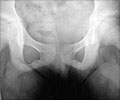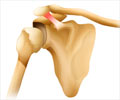- Clavicle Fracture (Broken Collarbone) - (http://orthoinfo.aaos.org/topic.cfm?topic=a00072)
What is Clavicle Fracture / Broken Collarbone?
Clavicle fracture or broken collarbone is a very common fracture that occurs in the young as well as the old. Despite its name, the collarbone or the clavicle isn’t situated around the neck. It is one of the two long, thin bones that connects the breast bone (sternum) and the shoulder blade (scapula) and helps to connect your arm to your body.
Collarbone fractures occur mainly due to accidents. It can occur either when you are hit or when you fall on your shoulders, hands or arms. The force of the accident can impact your collarbone, causing a snap. Most breaks occur in the middle third of the long clavicle; sometimes it occurs at the point where it is attached to the breastbone or the shoulder blade. The nerves and the blood vessels that lie beneath the clavicle are rarely injured during the fracture.

Clavicle fracture is particularly seen to occur in athletes. Falling from a bicycle is also commonly associated with clavicle fractures. In babies, collarbone fractures can occur at birth, during their passage through the birth canal.
Signs & Symptoms of Clavicle Fracture / Broken Collarbone
The symptoms of clavicle fractures include:
- Severe pain and swelling
- Sagging shoulder
- Bruising /tenderness over the region of the collarbone
- Inability to lift or move the arm due to pain
- A grinding sensation on attempting to raise the arm
- A "bump" or "tent" deformity over the region of break
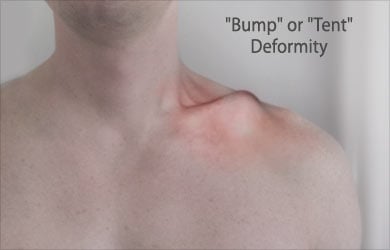
If pieces of the fractured bone have been moved out of position before healing occurs, it can result in a “malunion” which can lead to a deformity at the region of fracture. It is important to follow up with a doctor and ensure that the bones are in position before the healing takes place.
Diagnosis & Treatment of Clavicle Fracture / Broken Collarbone
While evaluating the fracture, a doctor will attempt to find out about the injury and how it was caused and then proceed to examine the site of fracture. The doctor will make sure that no blood vessels or nerves have been damaged.
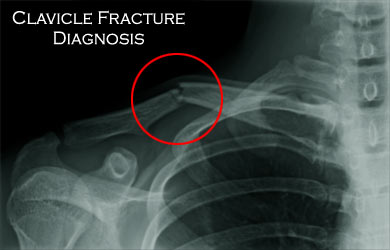
The doctor will order an X-ray to understand the severity of the fracture. If multiple fractures are suspected, a CT scan will be ordered.
A. Non-surgical Treatment
Typically a clavicle fracture will heal on its own, with time. If the broken ends of the fractured clavicle remains in line and has not shifted out of place then you may not require a surgery. For faster healing of the fracture, a few methods may be followed.
Some of the non-surgical treatments that may be considered include:
Arm slings / Support
Braces may be used to immobilize the arm and shoulder, while a simple arm sling may be used to provide comfort and help to rest the arm during healing.
Medication
Pain medication and anti-inflammatory drugs, including acetaminophen, naproxen or aspirin, may be administered to control pain, swelling and other side effects.
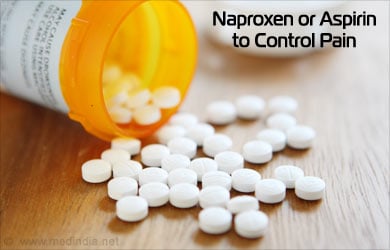
Rehabilitation
Once the pain decreases and the bone begins to heal, the doctor will get you started on shoulder and elbow exercises to help prevent stiffness and weakness. Specific exercises may be advised to strengthen the shoulders and to restore movement. Once the fracture heals completely, more strenuous exercises may be advised.
B. Surgical Treatment
If your bones are displaced due to the fracture your doctor will recommend surgery to align the bones and hold them in position until they heal.
Plates and Screws
Here the bone fragments are first placed in their normal alignment, and then held in place with the help of special metal plates and/or screws. These screws and plates are usually not removed after the fracture heals, unless they cause discomfort.
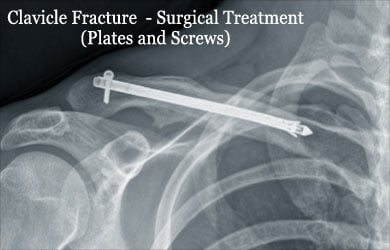
Pins
Pins are also used to hold the broken bones in position. The incision made for placing the pin is small in comparison to those made for plates. Pins are removed once the fracture is healed as they can cause irritation to the skin beneath which they are placed.
Surgical Complications
Those who are at high risk for complications include:
- Tobacco users
- Diabetics
- Elderly people
Risks include:
- Difficulty with bone healing
- Lung injury
- Irritation caused by pins/ screws/ plates
- Severe pain
- Infection
- Bleeding
- Formation of blood clots in the leg
- Blood vessels / nerves damage
Follow-Up
The fracture can move out of place before it heals. It is important to follow up with the doctor who may advise you to take X-rays to ensure that the bone has not moved out of place before it heals.
Treatment for "malunion" is determined by the degree of mal-alignment and the extent to which it affects arm movement.
Prognosis / Outcome of Clavicle Fracture / Broken Collarbone
A clavicle fracture takes several months to heal, whether you've had a surgery or not! It may take even longer for diabetics and the elderly. Physical therapy is compulsory for an early recovery to normal life.
In most cases the recovery time is about three months. But it is advisable to wait for your doctor to tell you when you are ready to return to normal activities. Trying to return to normalcy before your turn may cause the fractured bone to be displaced or hardware (pins, screws, plates) to break.

Ensure you return to your normal activities only after:
- You are able to move your arm and shoulder without experiencing pain.
- Your doctor has confirmed that the fracture is healed, with the help of an X-ray
A small bump may be seen over the fracture site even after healing. Once the fracture is healed, slightly more strenuous strengthening and a range of motion exercises will be recommended. You may then safely start indulging in your favorite sports or other activities.



